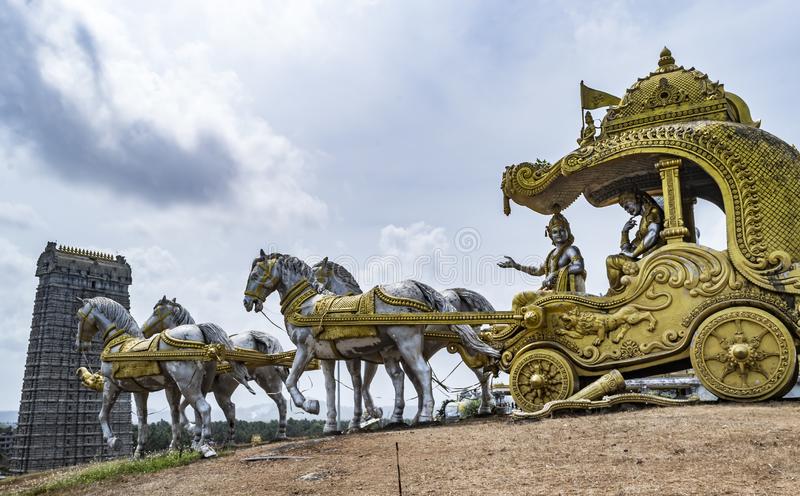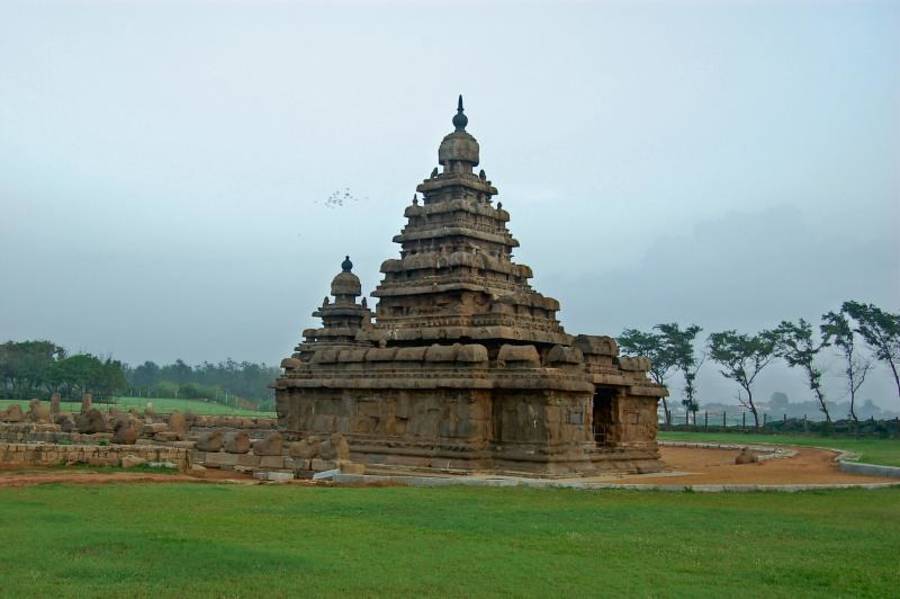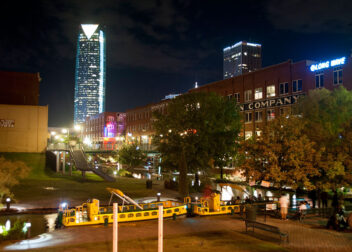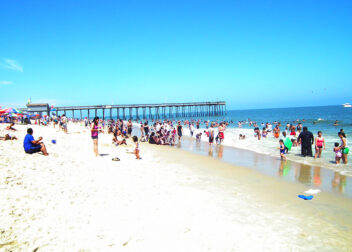Mamallapuram, Panch Pandava Rathas (Five Rathas)
Mamallapuram: Gosh, it was hot this day. Temps were close to 100º with high humidity and almost no breeze. Stepping out of the A/C car meant asking oneself, “why am I doing this today”? School buses were just arriving as my travel partner and I made our way toward the ticket booth. Tickets are sold, opposite the actual site, in the shopping and refreshment area. Swarms of kids, of all ages, were converging on the entrance guarded by two younger officials. They looked scared rather than confident guarding the entry. With ticket in hand, we walked the dusty trail to the “main entrance”.
Just inside the gate is a brief overview for tourists who didn’t come with any background knowledge. Although I had done my homework the night before, reading through various guide books on what we were embarking on, the trusty travel guide was in my possession. Truthfully it didn’t help at the time. With kids bouncing off the monuments, running and jumping about, it was hard to keep a focus on the direction. Looking back at the pictures it seems obvious to me. Must have been the heat. By the end of our hour-long visit, my back and front were soaking wet from perspiration.
A momma dog with her three pups greeted us as we made way for the cold refreshment stands. I’ve hardened to street dogs of India over the years, but traveling with a novice has shed new eyes on the issue once again. We stopped to hand over some snacks momma was in need of. It was obvious the puppies were hungry and still nursing when possible so momma needed to keep her strength. Whatever we could find was devoured in short order. The only thing left to do was leave and not look back, but I couldn’t help myself.
Before reaching the food/drink stalls there is a pay-to-use toilet for gents and ladies. This was needed, and as I dug into my pockets for change, the woman manning the desk abruptly ordered Rs 5 to go past. “Rs 5, you must be joking”, I exclaimed. “No, no, no. I will give you Rs 2 tops.” I said, to which she shook her head. Fine, I figured it could wait but she didn’t want to lose a customer. Rs 2 it was. Damn, this heat really makes one cranky.
Entry into Five Rathas is spendy at Rs 250 per person (foreigners) however it is a World Heritage Site. Be sure to do some research before arriving or grab a pick-up guide available as you near the ticket booth. Without either you’ll be lost and feeling like you overpaid.
PANCH RATHAS OR THE FIVE RATHAS
The five Rathas is a set of magnificent monolithic rock temples. Panch is a Hindi word which means ‘Five’. These fine rock temples are located in a sandy compound. These five Rathas are the perfect examples of the evolution of Dravidian style architecture. There are built in the shape of pagodas and they look similar to that of the Buddhist shrines and monasteries. Rathas in English means chariots. These chariots are constructed with Towers, The cars of gods, multi pillared halls, and sculptured walls which are chiseled out minutely. The Rathas have an association with the great epic Mahabharata which describes the heroes of Mahabharata with their wife Draupadi which is termed as Panch Pandava Rathas. The five rathas are (i) Draupadi’s Ratha, (ii) Arjuna’s Rath, (iii) Nakul – Sahadev’s Rath, (iv) Bhima Rath, and (v) Dharamraja Yudhistar’s Rath.
DRAUPADI’S RATH
This is located at the entrance gate, which is spectacular and simple, shaped like a hut, and is dedicated to the goddess Durga. Female doorkeepers stand on either side of the Rath, one holding a bow and another, a sword. At the eastern wall, a bas-relief stands portraying Goddess Durga standing on a lotus and two worshippers at her feet offering flowers and one of the person’s head respectively. Entry other walls have the figure of the great goddess, and at the front of the temple is a Lion’s figure, which is the celestial vehicle to the Goddess.
ARJUNA’S RATH

The next Rath is Arjuna’s Rath. This one is dedicated to Lord Shiva. This has a small portico and carved pillar stones. Inside the shrine, there are no inscriptions or figures whereas, on the outer walls, there are carvings of gods and humans. A panel on the northern wall is carved with two door-keepers. Beautiful carvings of Lord Vishnu and a Garuda on One panel and the other panel with a couple. The eastern wall is carved with a double Dwarka-Palace, in the middle wall the portrait of Lord Indra riding an elephant, a log standing of the left with his disciples, and two beautiful women are perfectly chiseled out. These beautiful carvings have been praised by many poets. There is also a figure of Nandi bull – which is still left unfinished.
NAKUL – SAHADEV’S RATH
In front of Arjuna’sRath is the Nakula – Sahadev Rath. This is a double decored building, dedicated to Lord Indra – the God of Rain. As in Greek and Roman mythologies, where there are different gods for various aspects and qualified, the Indian mythologies too lane assigned specific gods for different aspects. There is some proof depicting this Ratha to which might have been dedicated to Subramanya associated with elephants. The elephant’s shaped sculptures face towards the sea. One who eaters the Panch Rathas can visualize the back portion of the elephants and it named Gajaprishthakara which means elephant’s backside. The elephant sculptures are huge and are highlights of the PanchRaths.
BHIMA RATH
This Ratha is faced towards the west and this is laid third of the Rathas. The shrine is gorgeous as it measures 42 ft in length, 24ft in width, and 25ft in height. The pillars are lion carved whereas the other parts are plain. This Ratha too is an incomplete one. In the epic Mahabharata Bhima, the huge guy is bulky and strong he is fond of eating all the time.
DHARMARAJA YUDHISTAR’S RATH
Of all the five Rathas, this last one stands huge. It is named after the eldest of the Pandavas. Innovative and well-carved designs can be seen in this Rath. This resembles the Arjuna’s Rath and it is a perfect example of the later built South Indian Temples. This Rath is also dedicated to Lord Shiva like that of Arjuna’sRath. The ground floor is incomplete. Above the ground floor stands a minutely designed double floor. The peculiarity in this monumental construction is that there is no stair route from the ground floor to the first floor, but, therein stairs from the first floor to the second floor. There are eight panels on the ground floor. One panel is carved with the portrait of the kind and the rest with gods and goddesses. On one particular wall, the figure of shiva is named ‘Ardhanariswarar’ which is the mixture of Shiva and Shakti. This is very attractive as one can find the manly structure and the luring female charm. Other portrayals show lord shiva as ‘Bhikshatana’ – meaning cosmic designer and the god of death.
Twenty-two carves are found on the first floor. There is no central pasteurization on the first floor. The portrait of Lord Krishna dancing on top of the fierce kaliya snake is depicted on the southern wall. Lord Vishnu’s portrayal is found on the Northern wall. Carving of a bearded ascetic holding a bell in his hands, a devotee with a tuft, holding a flower basket, a temple attendant with a bunch of keys, and carrying offerings to god are marvelously inscribed. The second floor is well carved. Figures of Dakshinamurthy, somaskanda, the sun the moon, and other worshippers all found on this floor.



